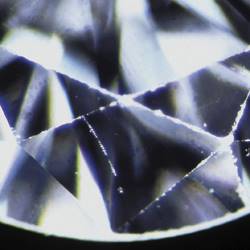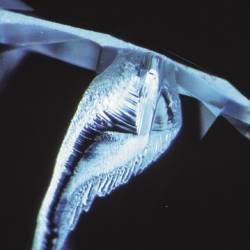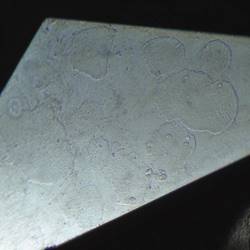
1. Worn edges and corners on a brilliant cut diamond with a scratch across a main facet. Diamonds are not indestructible.
Image Gallery (17 Images)
Caring for precious gems
 13.8 k views |
13.8 k views |
Gems can exhibit many different types of damage, including that caused
by accident or negligence. With a little knowledge, such damage can
often be avoided. PROFESSOR HENRY A. HÄNNI discusses the how and why of
gem care.
Over many years working in the Swiss Gemmological Institute gemmological laboratory in Basel, Professor Hanni has encountered numerous gemstones with old or recent damage, always with the clients’ explanations about the possible reason.When Professor Hanni recently witnessed the relative ease of chipping smoky quartz during setting, his thoughts turned again to the limited durability of gemstones. He was also intrigued by a significant number of cases of damage to or flaws in diamonds that appeared to have been systematically-generated in diamond cutting factories during the cutting process. He shares his findings here.
The potential for damage depends on the different characteristics of gemstones, such as mechanical resistance, chemical resistance, thermal stability, stability of colour and the way in which a stone is cut.
Damage may occur by mechanical or thermal exposure and also by chemical attack. Damage to a gemstone may also occur because the wearer believes in the idea that “a diamond is forever”. Different types of damage are listed below, as well as an analysis of the reasons for damage that unveil the critical moments during mining, cutting, setting, wear and tear, repair and cleaning. All gemstones can be subject to damage. This article discusses some critical moments and how damage can be avoided.
Diamond
Diamond has a high scratch hardness, but is very sensitive to percussion and pressure during daily wear. Because of knocking with other diamonds, facet edges and corners appear white after a period of wear (image 1).
Sharp-edged or thin girdles on diamonds are particularly vulnerable to damage; they can chip during setting or later (image 2). But rough usage of diamond-cutting tools may have already created pressure or knocking fissures in the cutting factory; numerous diamonds leave the factory with small percussion marks and scratches due to careless handling.
Another kind of damage to a diamond that may occur during the cutting process is a burned surface. The heat produced by the friction if the diamond is cut too quickly allows carbon atoms from the diamond surface to react with oxygen from the air and form volatile carbon dioxide (CO 2). This gas forms at the expense of the diamond surface, which consequently is corroded and shows whitish burn marks (image 3). Boric acid is usually used to cool the diamond and coat it with an air-proof flux layer that inhibits the corrosion.
A frequent source of damage to diamonds is during repair of mountings when soldering is necessary. The flame of a torch is hot enough to cause the diamond to form CO2 with the air.
A simple remedy against this corrosion is the application of a coating: a borax or boric acid layer protects the diamond and stops oxygen reaching the surface. Any fat or dirt, however, produces holes in this layer, and corrosion can take place (image 4). Therefore rings or other items of jewellery must be thoroughly cleaned before soldering. Surfaces of all diamonds must be coated with the protective borax layer when a ring goes under the torch.
Although soldering with a laser does not heat up the mounting or the stone, special precautions must be taken. Laser soldering may be dangerous for mounted diamonds since the energy of a laser shot may transform diamond into graphite. Either directly shot into the diamond or by reflection on the polished metal, the concentrated energy can quickly transform diamond into graphite. Graphite has a less dense atomic structure, and a transformation from diamond to graphite increases the volume of the treated area by 1.6. If such a phase transition is just beneath the surface of a diamond, the pressure will burst the spot and a crater will be formed (image 5). A coating of black ink would stop a laser penetrating the diamond and would be good protection against such damage.

2. Chip on the girdle of a diamond, situated where the girdle is thin. Thin or sharp-edged girdles are potential damage zones.
Ruby and sapphire
Corundum is a remarkably tough stone for a ring and is much less prone to chipping than diamond with its perfect cleavage; however, wear marks like rubbed edges and corners must be expected if sapphire or ruby-set rings are worn regularly over a long period of time (image 6). If the corundum contains twin planes, these can behave like poor cleavage and be more of a problem; secondary minerals such as boehmite may crystallise on twin planes and create weakness.
Generally, ruby is much more affected by the formation of thin twin lamellae than sapphire. This can also lessen the transparency of ruby and represents a source of damage when force is applied, for example, in setting; however, most of the rubies in the marketplace are heat-treated with additives such as borax – the “gluing effect” of which lessens the weakness and makes the problem of parting less likely.
A severe case of damage was encountered with an unheated ruby of over 10-carat that had been removed from its setting and was re-set with an inappropriate tool for closing the setting. The cushion-shaped stone showed two significant chips on opposite corners. I assume that the claws were resistant to the pressure applied when the stone was reset, so pliers were used to bring them back in position, allowing more force to be applied, and the stone shattered internally (image 7).
In some stones, existing damage can be hidden or disguised by filling the open fractures with wax. Such fractures can become noticeable later, after thorough cleaning, and although the appearance of a fissure may be new for the owner, an insurance company would not consider this fracture as new damage.
In rings containing sapphires or rubies, torch soldering can cause damage to the stones despite their usually good reaction to heat. In contrast to diamond, any borax should be kept well away from such stones – molten borax is a solvent for most minerals and corundum can be heavily etched from such melt (image 8). Resulting corrosion can only be removed by re-polishing.
Damage in corundum can be caused, although rarely, if a radioactive mineral inclusion is too close to the surface. The decay of uranium or thorium in zircon, uraninite or thorianite, for example, increases the volume of such inclusions.
This creates stress in the surrounding host mineral and leads to fractures emanating from the inclusion. When such grains are close to the surface, the tension may “spring” a thin layer of corundum (image 9).
Despite its toughness, corundum is frequently damaged by careless gemstone setters who support their setting hammer on the stone instead of supporting it on the metal only (image 10). Closed settings often mask such injuries and the damage only becomes visible when the stone is unset. A typical example is shown in image 11, where a significant chip in the sapphire was exposed after it was removed from the setting. Re-shaping the contour of the stone results in big weight loss.
Other accidents happen with re-sizing, where stones may be deeper than the depth of the ring head. On the sizing triblet or mandrel, the culet of the gem touches the metal and hammering the ring causes the stone to break; a sizing stick with a groove will avoid such damage (image 12).
Emerald
Emeralds are probably the gemstones most commonly associated with visible or hidden fissures. Tension in the crystal structure due to chemical substitution, tectonic forces on the parent rock and shocks during mining and separating the crystals from parent rock probably all contribute to the relatively high frequency of fissures in emeralds.

3. Burned surface spots (burn marks) on a star facet of a brilliant-cut diamond. (10x magnification).
They are often not recognised, due to effective fracture filling, and nowadays, sophisticated filling is standard wherever an open fissure appears.
A later cleaning process, however, may remove some filling and allow air into the fissures, making them easily visible. Fissures in emeralds are generally present prior to the cutting process, a fact that can be deduced from polishing marks that emanate from the fissure openings. Organic fillings are usually visible in a dark room under long wave ultraviolet illumination: oil often appears yellow, whereas artificial resins appear bluish-white.
Peridot
When a peridot was sent for analysis of the loss of lustre, it was first thought that a poor polish was disguised with surface waxing or oiling. The client, a goldsmith who bought the peridot from a cutter who had polished the stone himself, said that he had just cleaned the ring after having set the stone. Initially it was thought that the polishing had been carried-out with poorly-graded diamond powder, but a reference peridot from the same cutter showed perfect polish. After some questioning about his cleaning, the goldsmith mentioned submersion in pickling solution.
A short experiment revealed that the said solution was able to attack the surface of olivine, a new experience for a gemmologist but maybe an old fact for an experienced goldsmith. The reference peridot is shown before and after its bath in hot pickling solution composed of sulphuric acid and nitric acid as it is commonly used in jewellery workshops (image 13).
Tourmaline
During cutting, tension in some tourmaline crystals may be so strong that stones crack when they are sawn with the diamond blade. Heat treatment of tourmaline to enhance the colour can render broken stones. Some tourmalines make it to faceted gems but might later crack or shatter at the slightest stress. Soldering a ring that contains a tourmaline is risky and should be done with care.
Heat or ultrasonic vibrations may produce sufficient impulse for damage. Also the slightest scratches on the surface may release tension that causes a stone to crack (image 14); however, most tourmalines are not under tension and do serve many years as perfect gems.
Jadeite
One client decided to have a pendant made from a small jade doughnut ring that she bought while overseas. The goldsmith produced a gold mounting and polished the pendant. During the process of ultrasonic cleaning in hot soapy water, small parts from the surface broke-off so that the surface structure became coarse. In the lab, the jade was identified as B-jade – impregnated jadeite jade with an open structure. The filler and some loose surface jadeite had disintegrated and left an item that was unacceptable to the client (image 15).
Opal
Opals are among the more sensitive gemstones. Drying-out is said to be the reason for their reported weakness. Some opals become fractured and show a web-like network of fine fissures. It goes without saying that a flat stone in a bezel setting would probably not survive a re-sizing of a ring because of the tension induced in the mounting. The flat cabochon illustrated (image 16) reacted to the slight deformation of the bezel setting.
ABOUT THE AUTHOR
Professor Henry A. Hänni FGA is from the Swiss Gemmological Institute, Basel, Switzerland. This article was first published in Gems & Jewellery, April 2009, pages 3-8. Reprinted by kind permission of the Gemmological Association of Great Britain and Professor Henry Hänni.
Posted September 01, 2009